The checkout from Panama went smoothly. Stanley, our agent, showed up at the boat at 12pm Panama time (that’s 10am normal time) to collect our passports. Half an hour later he returned with the necessary paperwork for our departure. A Zarpe, a customs document, a Panama cruising permit and a fumigation report for the Galapagos Islands. We were good to go.
A quick dash to the neighbouring Flamenco marina for the last supplies, a can of oil for our new two stroke engine, some more food from the Motta deli and sandwiches for our first meal aboard.
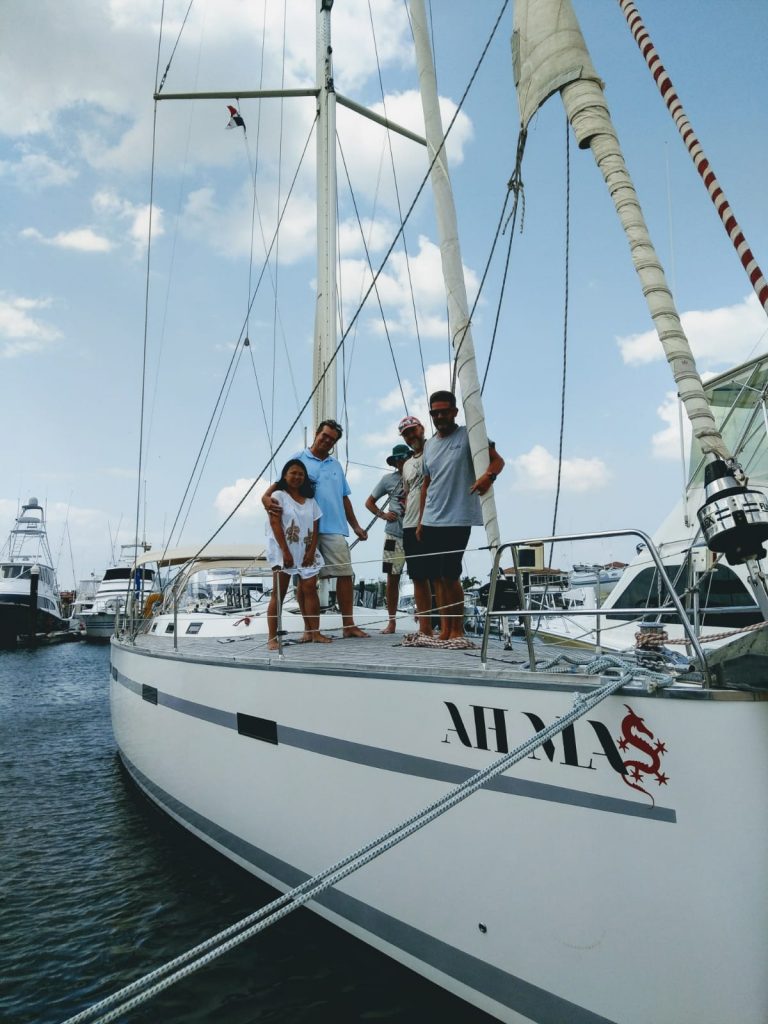
We finally left the La Playita Marina at 14:30 on Friday the 6th of March. Our skipper for hire and his first mate took control of setting the sails and watch schedule. Me and Linda would have the 2am, 10am and 6pm shifts for the coming days ahead. The distance to the Galapagos island is roughly 700 miles as the crow flies, we hope to arrive there in 5 to 6 days, weather permitting.
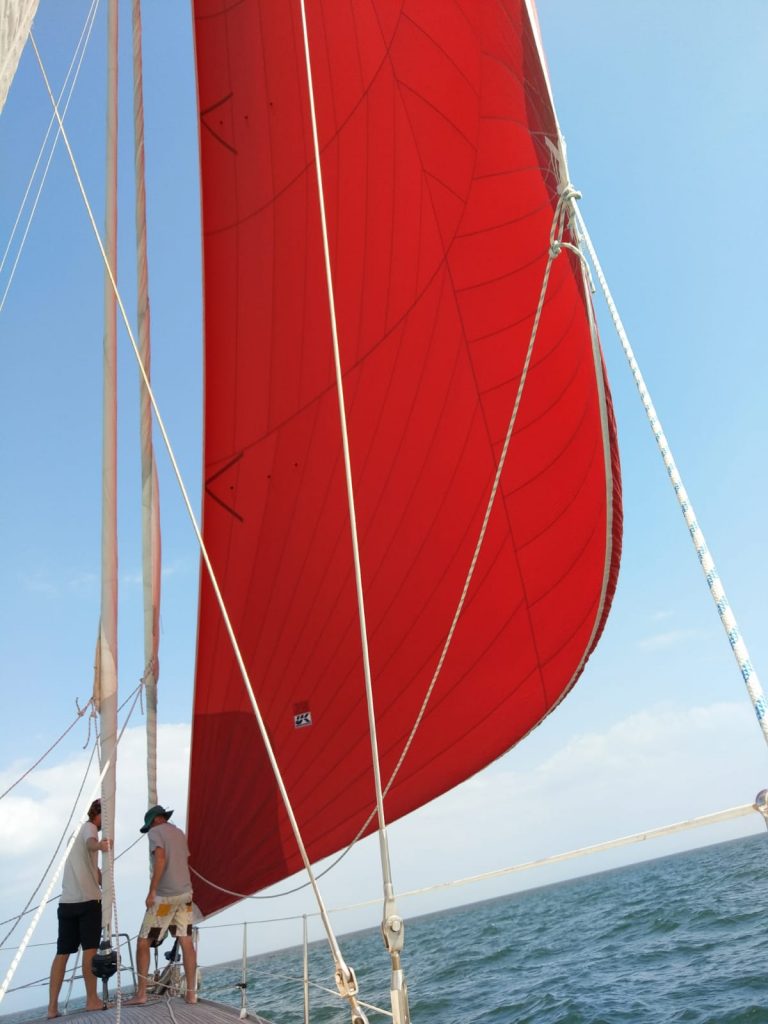
The first couple of hours we took our giant red gennaker out and made way at 8 to 9 knots, but soon the wind became too much for the big red thing’s thin fabric. We rolled her back in and continued on the normal genoa and main, occasionally clocking double digit speeds with the wind on our aft quarter. Ah Ma was in her element as we quickly left the polluted Panama waters behind us.
Around sunset the wind died down and our Volvo rumbled into action for some motor sailing while we enjoyed our sandwiches. Linda and I turned in immediately after our evening watch, tired from a long day of running around.
The first night watch presented a clear sky with a good view of the stars and the almost full moon. We are only 8 degrees off the equator, but it’s chilly outside. Luckily Linda has her warm Goisco blanket and under the dodger the wind doesn’t get to you that much.
We sailed up to the Northerly tip of the Panama basin, punta Mala, trying to keep in the area of wind predicted by the Grib files we downloaded.
Grib files are weather predictions that show where the wind (should) be in the coming days. We can download these through the Iridium satellite device.
When we reached Isla Iguana we jibed, crossing the last of the traffic separation zones, we were alone at last. Not a single ship to be seen on the AIS or radar.
Saturday 7th of March.
The next morning during our watch I decided to take out the professional fishing rod I got from Willo in Curacao. We didn’t expect to catch anything, as we are not really fishing people. Aside from a day of trout fishing on lake Omu in New Zealand. But beginners luck struck within 15 minutes. yay!
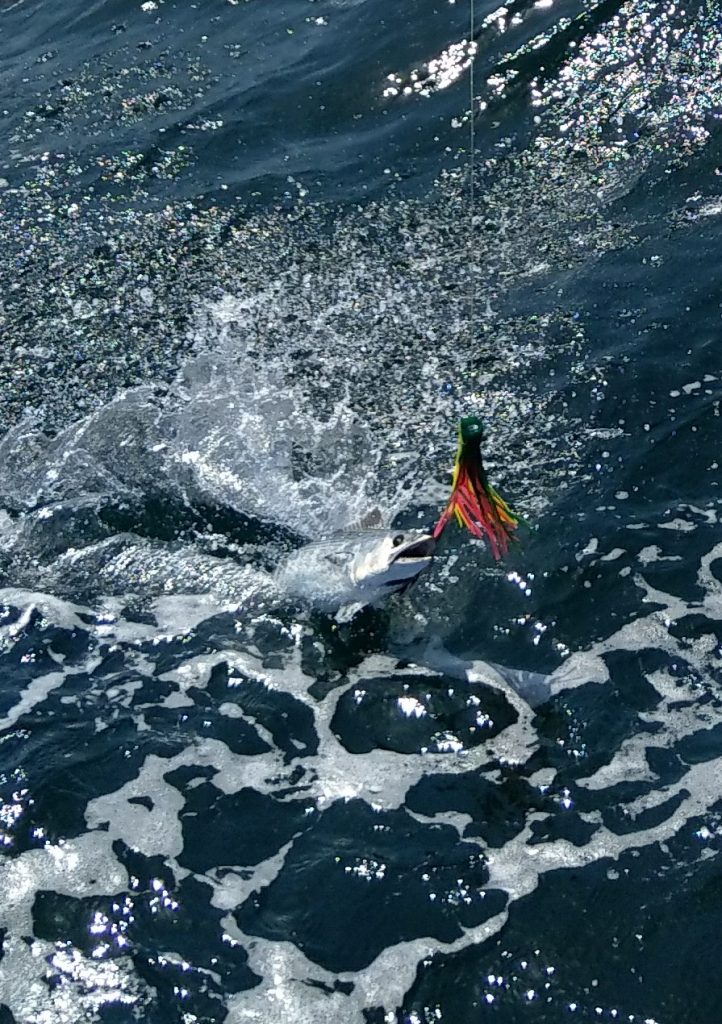
A small skipjack tuna took the shiny bait and was hooked on. We quickly reeled her in. With the help of Dr Ignasi and our first mate the tuna was killed and cleaned in a heartbeat. Ready for a sashimi lunch after a quick rinse with seawater and firming up in the freezer for a bit.
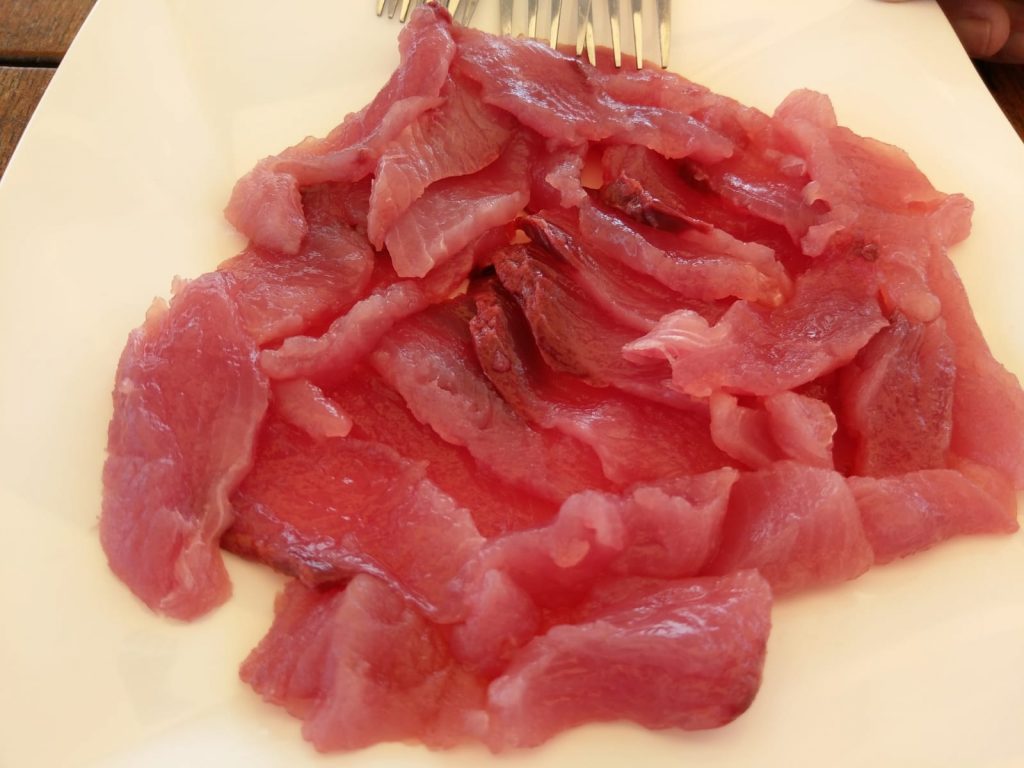
That afternoon the generator gave us another headache. There was coolant leaking from the discharge valve. Probably a rubber fitting that corroded over time. Our skipper and I got to work on it, but were puzzled by the temperature of the cooling liquid pump. It seemed to run hot, but then again we don’t know how hot it should get. We decided to put the thing back together and see if we can find some instructions when we get to port.
Around sunset the wind dropped down again. The engine was brought back to live. Linda braved being tossed about in the rocky galley below. Together with the ‘rice master’ first mate she cooked up some black bean pepper pork chops with onions and rice. A treat after a long day at sea.
The rest of the evening was uneventful, low winds, occasionally picking up to mid teens. We crawled through the night with a reef in the sails, so not to be surprised by sudden gusts.
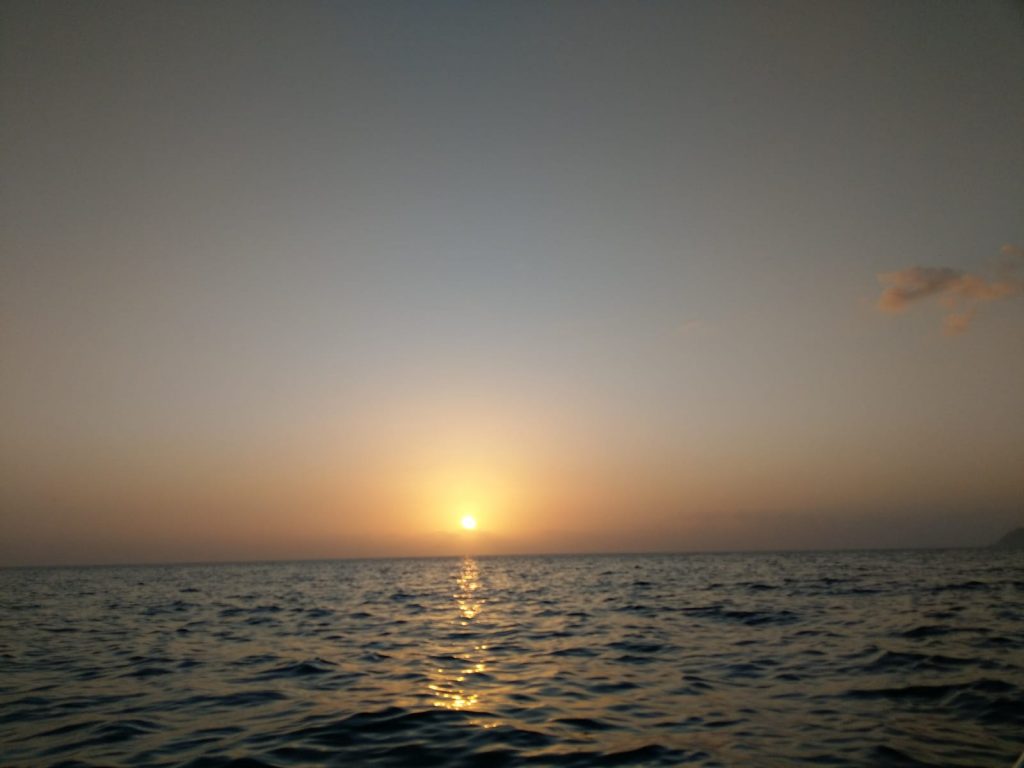
Sunday 8th of March
The day started off with a pot of coffee and some cereal. We have good winds in our aft quarter, so we are trying to find the perfect balance between the desired course and the luffing of the genoa.
Luffing is when the sail starts to ‘bang and flap’ when it does not get full of wind. This can happen when the main sail ‘steals’ the wind from the genoa. Or when the mast is tossed sideways to much by the waves.
We are doing a good 8 to 9 knots. And we are only 4 degrees off the equator now. Every degree is 60 miles, so another 240 miles till the milestone marker of the equator. I hope Poseidon takes it easy on us. Our skipper is the only one that has crossed the equator before, so the rest of us are considered landlubbers.
During the morning watch I fixed the outdoor shower and gave the cockpit a good fresh water rinse. The sea conditions got more choppy during the afternoon. This didn’t help Linda, as she was not feeling too well today.
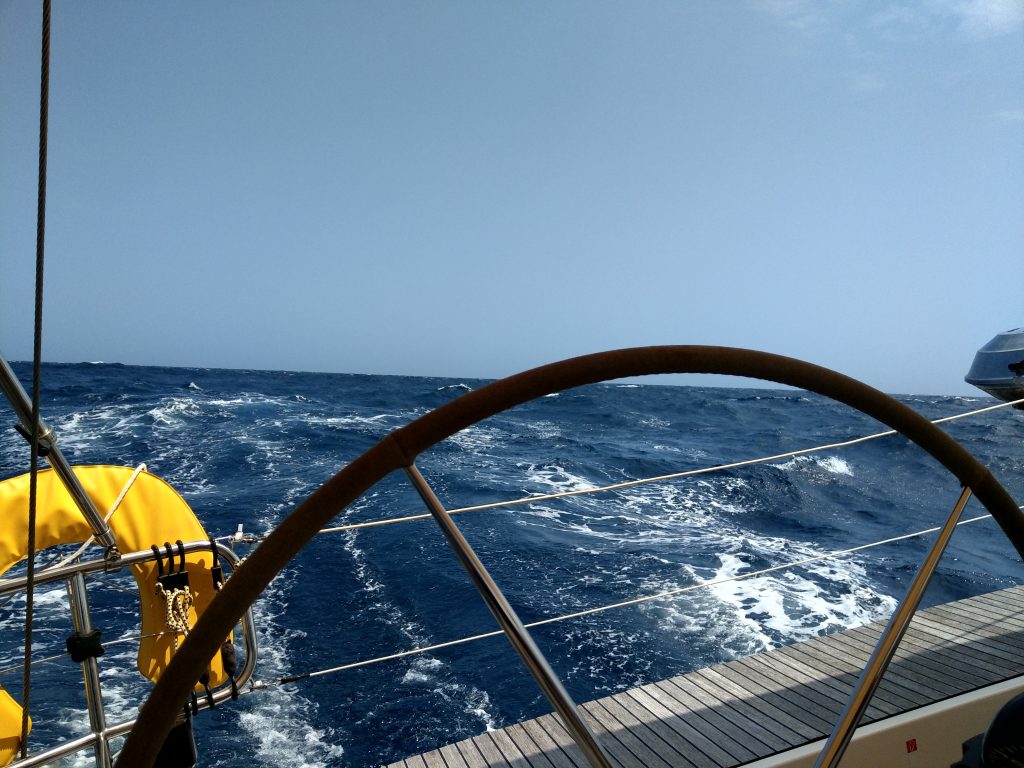
Continued 20 knots wind pushed us along at 8+ knots in more or less the right direction. In the afternoon we finished off the remainder of our freshly caught tuna. Chopped into dices over some reheated rice.
The day passed by quickly, along the way we saw two turtles floating past the boat. Flapping their way in the opposite direction, towards the shores of South America.
During the night we could feel that we were getting closer to the equator. It was warm and damp down below. We are now close to 3 degrees north. Each degree is 60 minutes, and each minute is a nautical mile. So less than 180 miles to go to the equator.
I would expect the wind to drop off at any time as we would be entering the doldrums. This is the area around the equator where northerly and southerly currents converge. The water is expected to be flat and winds non-existent.
Monday, 9th of March
The next morning we were still racing along at up to 10 knots. A strong push from the currents and a consistent 15 knots breeze made for great sailing. The waters got more ‘organized’, the pacific swell dominated the movement of the boat.
For lunch I made the crew some chicken fajitas, and for dinner Linda and I prepared a potato gratin to accompany the last bits of leftover steak from Curacao. This was the most remote BBQ any of us had ever had.
Soon after we turned in we started to hear the sails banging. A tell tale sign that we reached the end of the wind.Our first mate and skipper rolled in the canvas and started up the Penta. With a heavy push from the currents we are now bearing straight towards the Galapagos, a mere 340 miles due South West.
Tuesday, 10th of March
On the morning shift our first mate spotted some dolphins playing in the bow wave. Other than that there weren’t much signs of life other than the occasional bird skimming the tops of the waves.
The monotone sound of the engine dominated the day as we ploughed through the flat waters of the doldrums. An occasional squall brought some refreshing rain. Later in the afternoon a light breeze arose from the South. With the engine giving a push and all canvas hoisted, we pushed forward at 7 knots, inching closer to the Galapagos Islands
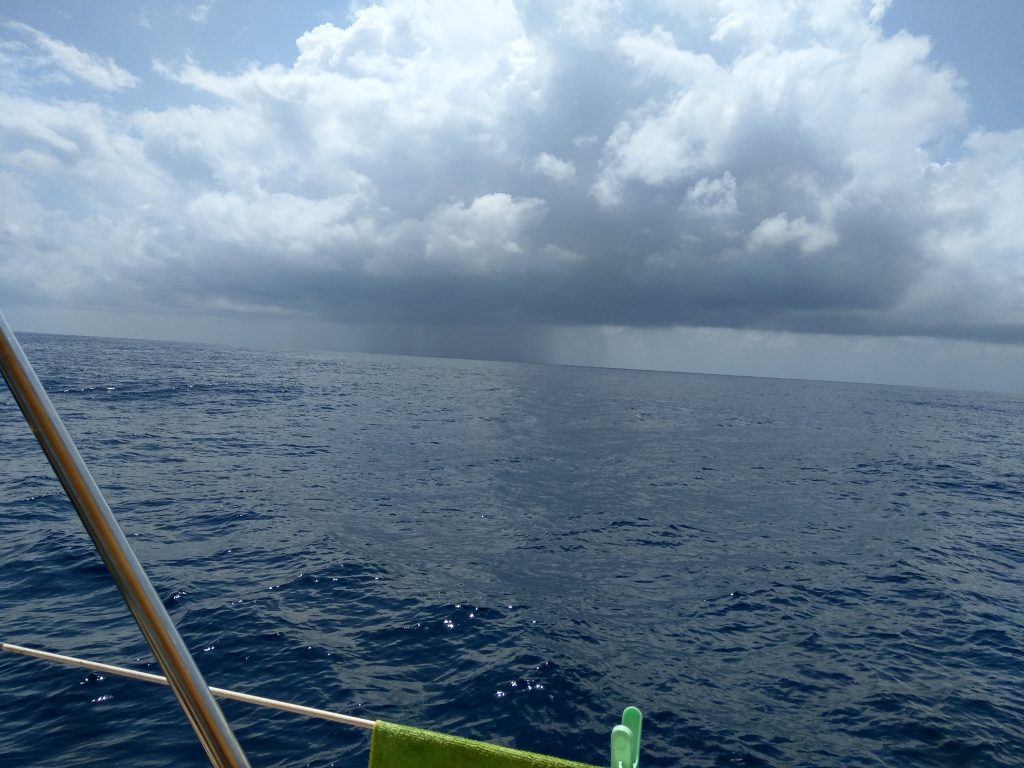
As the wind increased we could finally silence the Penta. The diesel tank had roughly a quarter left on the gauge so it was time to fill it up. Five jerrycans were pulled from the sail locker and siphoned into the tank. With these numbers and the engine hours we could finally calculate the average usage of the engine, appropriately 4 litres an hour as expected. This is good news, as it turned out our heavy propeller pitch does affect the fuel consumption too much.
In the afternoon I was staring at the endless waves. Then suddenly we got an unexpected visitor. A small bird landed on my head, yes on top of my head! That was a bit of a frizzle. After taking off and flapping around the boat for a bit she landed again in the cockpit. She was clearly exhausted and far far away from home.
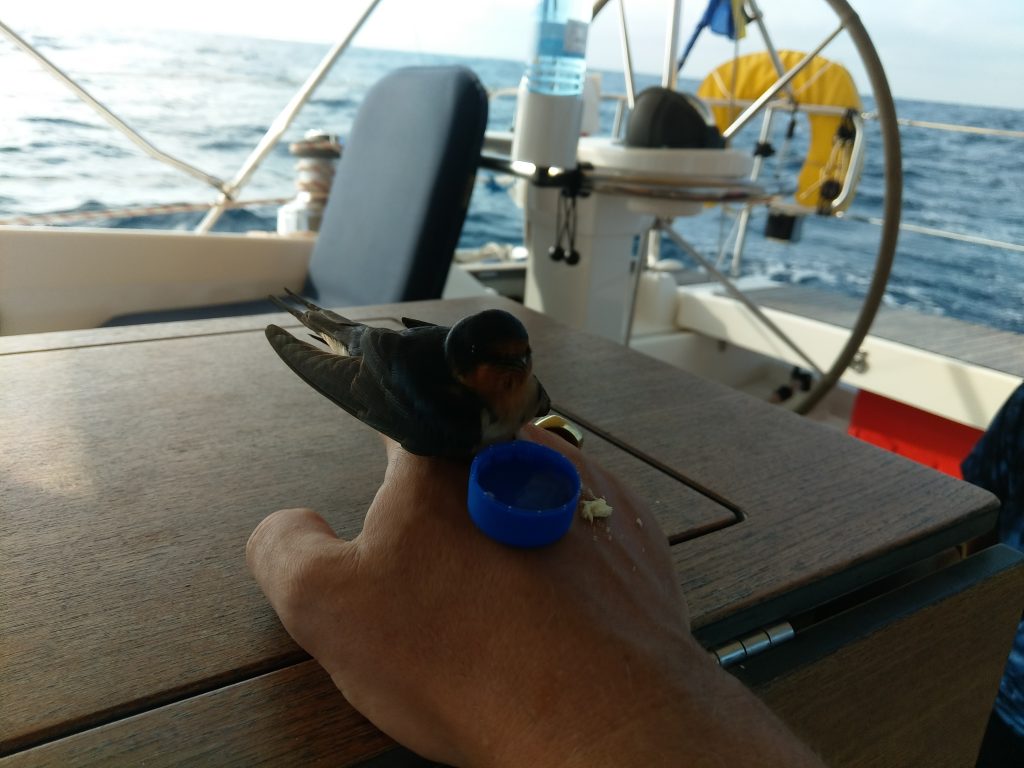
Dr. Ignasi and I gave the bird some water and saltine crumbles while she was resting on my hand. As we tried to move her to a towel, she decided that inside the galley was a better place to hide, giving Linda a bit of a scare.
Our new boat bird first took a spot on top of the refrigerator and later found a quiet spot on top of the printer to rest up. We’ve named her Galley, the birdy from Galapagos. She looks tired and exhausted, I hope she will make the morning.
The night watch from 2 to 4am offered some great sailing, with 10 to 12 knots of wind abeam (on the side of the boat). Ah Ma stretched her legs at 8 to 10 knots racing closer towards the equator. At some point we need to manage the speed, otherwise we’ll be arriving at the islands in the dead of night which would not be desirable.
Wednesday, 11th of March.
The morning ritual was the same , coffee, some cereal and start of our watch at 10:00am. The winds died down a bit and we furled in the genoa to get a straighter angle. If we are on a too heavy starboard tack, the generator doesn’t suck in sea water for cooling. On engine we started the water maker to fill up the depleted front tanks. About 130 miles to go to the anchorage.
Our boat guest, Galley, is in weak condition. Dr. Ignasi is doing the best he can to comfort her. We think she won’t make the end of the day.
In the afternoon the penta has to create some ‘diesel wind’ to push us along. At this pace we will reach the equator around 20:00, and the Galapagos early tomorrow morning.
Our skipper pointed out some perceived ‘delamination’ in the main and genoa. We would need to find some sail tape in the Galapagos and spare the Genoa and main as much as we can to prevent further damage. It is time to look in to getting some new sails. Another thing for the to-do list. We also must find a way to get water to the generator whilst under way, so we need to do some plumbing when we get to port.
Crossing the equator was uneventful. We all watched the counters on the GPS pass zero, and went on about our business. It would have been up to the Skipper to perform the necessary rituals, as he is the only one that crossed before. But our skipper is not the most socially skilled person, so we did not expect anything there.
Thursday 12th of March.
Motoring through the windless night dodging a fishing boat just of the coast of Isla Santa Fe. We are bound to arrive at the Academy bay anchorage around 9am.

Our skipper found a spot for our anchor and secured the boat. The island looks calm and green. The small town peaceful. The signs of mass tourism haven’t scarred the island too much yet. The anchorage is filled with about 25 yachts and boats.

The presence of half a dozen big tourist boats show that the thirst for tourism dollars is slowly taking prevalence. But the Galapagos are only for those with deep pockets. For us, just to stop here for 7 days to replenish supplies, we need to pay almost us$2000 in fees and taxes. If you decide to extend the visit with some cruising around the islands you can add another couple of thousand dollars for a cruising permit. You’d almost be tempted to skip the Galapagos whilst crossing the Pacific, but it is the last stop before thousands of miles, so you kind of need to take the opportunity to resupply.
The check in procedure went without incident. A delegation of eight officials boarded the boat for the necessary paperwork. Within an hour all forms were filled in and all stamps placed. We have now officially arrived at the Galapagos.

